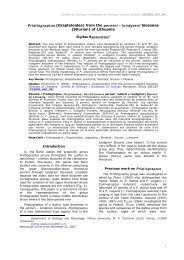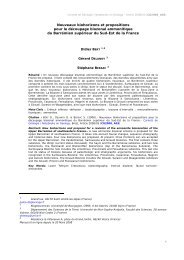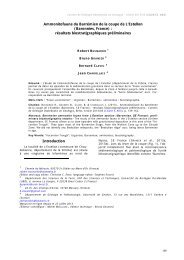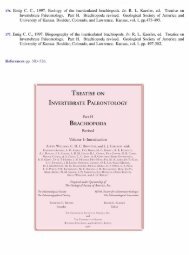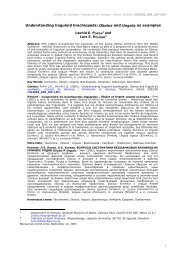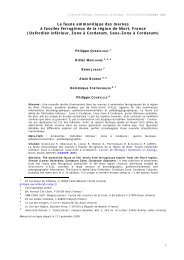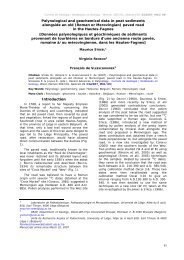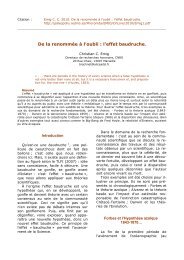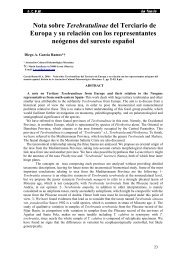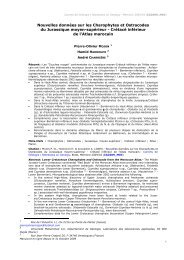The Salt Range: Pakistan's unique field museum of ... - Paleopolis
The Salt Range: Pakistan's unique field museum of ... - Paleopolis
The Salt Range: Pakistan's unique field museum of ... - Paleopolis
- No tags were found...
Create successful ePaper yourself
Turn your PDF publications into a flip-book with our unique Google optimized e-Paper software.
Bandarkas Gypsum Member contains marland huge deposits <strong>of</strong> crystalline and noncrystallinegypsum (Fig. 5). <strong>The</strong> Sahwal MarlMember contains marl along with 8-10 feetthick seams <strong>of</strong> rock salt. At the top <strong>of</strong> thismember in the Khewra area, an igneous volcanicbody is exposed known as ‘Khewrite', whichresembles an igneous body that occurs with thePre-Cambrian Harmuz <strong>Salt</strong> <strong>of</strong> Iran. <strong>The</strong> sharpcontact between the <strong>Salt</strong> <strong>Range</strong> Formation andthe overlying Cambrian Khewra Sandstone(Figs. 2 & 6) can also be observed in the gorge.Carnets de Géologie / Notebooks on Geology – Book 2009/03 (CG2009_B03), Chapter 6PALEOZOIC ROCKS<strong>The</strong> Paleozoic rocks exposed in the the <strong>Salt</strong><strong>Range</strong> are <strong>of</strong> Cambrian and Permian age, withno strata representing the Ordovician toCarboniferous systems. <strong>The</strong> Cambrian sequencecomprises four formations:Figure 9: <strong>Salt</strong> pseudomorphs in the BaghanwalaFormation.4- Baghanwala Formation3- Jutana Formation2- Kussak Formation1- Khewra SandstoneFigure 10: <strong>The</strong> Permian Warchha Sandstoneoverlying the Dandot Formation exposed along theKhewra-Choa Saidan Shah road.Figure 7: Roadside geology showing the contactbetween the Baghanwala and Tobra Formations inroad cuts.Figure 8: Contact between Baghanwala Formation(with salt pseudomorphs) and the overlying Permianglacial Tobra Formation.<strong>The</strong>se Cambrian formations contain (apartfrom other fossils) a wealth <strong>of</strong> trace fossils,including trails <strong>of</strong> trilobites and worm tracks.<strong>The</strong> Khewera Sandstone shows honeycombweathering, cross-bedding and interaformationalfolds. <strong>The</strong> Baghanwala Formation(Figs. 7-8), which contains salt pseudo-Figure 11: Permian Amb Formation, Pail Area.68
Carnets de Géologie / Notebooks on Geology – Book 2009/03 (CG2009_B03), Chapter 6morphs (Fig. 9), is well exposed along theroadside and displays a sharp unconformableupper contact with the overlying Permian glacialdeposits.alternating glacial and stream (ice melt water)deposits. <strong>The</strong> other formations <strong>of</strong> the group, theDandot Formation and Warchha Sandstone, arealso well exposed along the Khewra-ChoaSaidan Shah road with a sharp contact betweenthem (Fig. 10).Figure 12: Fusulinids beds the Amb Formation, PailArea.Figure 15: Middle Productus Limestone in NammalGorge.Figure 13: Fusulinids in the Amb Formation, PailArea.Figure 16: Productus exposed in the limestone inNammal Gorge.Figure 14: A view <strong>of</strong> Nammal Gorge.<strong>The</strong> Permian strata <strong>of</strong> the <strong>Salt</strong> <strong>Range</strong> areassigned to two groups, the Nilawan Group andthe Zaluch Group. <strong>The</strong> oldest formation <strong>of</strong> thePermian, the Tobra Formation <strong>of</strong> the NilawanGroup, is a non-marine deposit that showsdifferent facies across the region. In the eastern<strong>Salt</strong> <strong>Range</strong>, it is tillitic (glacially deposited),grading into a marine sandstone; in the central<strong>Salt</strong> <strong>Range</strong> it incorporates lacustrine deposits;in the western <strong>Salt</strong> <strong>Range</strong> and Trans Indusranges it displays a complex facies <strong>of</strong>In the central <strong>Salt</strong> <strong>Range</strong> near Pail the AmbFormation, the youngest formation <strong>of</strong> theZaluch Group, is very well exposed along theroadside, where it contains numerous fusulinidbearingbeds (Figs. 11-13). Further west in theNammal Gorge (Fig. 14), the Wargal Formation(formerly known as the Middle ProductusLimestone) and the Chhidru Formation (formerlyknown as the Upper ProductusLimestone) are exposed, and bear abundantspecimens <strong>of</strong> Productus and other brachiopods(Figs. 15-16). <strong>The</strong> Permian rocks have a sharpupper contact with Triassic rocks, marking aparaconformity. <strong>The</strong> Permian rocks aredistinguished by the presence <strong>of</strong> Productus,whereas the Triassic rocks contains Ceratites.MESOZOIC ROCKS<strong>The</strong> Triassic Mianwali Formation is very wellexposed in the Nammal Gorge as well as in theDhak Pass, where beautiful Ceratites specimenscan be found along the roadside (Figs. 17-19).<strong>The</strong> lower contact <strong>of</strong> the Mianwali Formation69
<strong>The</strong> non-marine Miocene-Pliocene rocksknown as the Lower and Upper Siwaliks (Figs.26-28) are famous for their vertebrate faunaincluding mammals (among which is the largestmammal), birds and reptiles.Carnets de Géologie / Notebooks on Geology – Book 2009/03 (CG2009_B03), Chapter 6Figure 25: <strong>The</strong> Choegali Formation <strong>of</strong> Eocene agecontains numerous Nummulites, shown in this image.Figure 22: <strong>The</strong> Paleogene Lockhart Limestoneexposed along a road side near Nammal Gorge.Figure 26: <strong>The</strong> Lower and Upper Siwaliks, nonmarineMiocene-Pliocene rocks, occur in the <strong>Salt</strong><strong>Range</strong>.Figure 23: Nodular foraminiferal limestone beds inthe Lockhart Limestone.Figure 27: Differential weathering and badlandsexposures in the Siwaliks.Figure 24: Sakesar Limestone.71
Carnets de Géologie / Notebooks on Geology – Book 2009/03 (CG2009_B03), Chapter 6Figure 28: Vertebrate fossils are well preserved andabundant at localities in the Siwaliks.4. Recommendations<strong>The</strong> <strong>Salt</strong> <strong>Range</strong> contains a number <strong>of</strong> <strong>unique</strong>fossil occurrences and many occurrences thatare useful in research and education. It shouldbe considered carefully by local paleontologistsfor the preservation and conservation <strong>of</strong> theseresources. Those sites (<strong>of</strong> any geographicextent) that are deemed worthy <strong>of</strong> preservationshould be designated a potential PaleoPark andlocal efforts to preserve them should ensue.This will require significant efforts because <strong>of</strong>the numerous sites, and the size andpaleontological fame <strong>of</strong> the <strong>Salt</strong> <strong>Range</strong>.Acknowledgements<strong>The</strong> author is grateful to Pr<strong>of</strong>. Jere H. LIPPSfor encouragement, guidance and editing, andto Pr<strong>of</strong>. Richard J. ALDRIDGE for editing the text.Bibliographic referencesAFZAL J. (1997, unpublished).- Foraminiferalbiostratigraphy and paleoenvironments <strong>of</strong>the Patala and Nammal formations at thePaleocene-Eocene boundary in the <strong>Salt</strong><strong>Range</strong> and Surgar <strong>Range</strong>, Pakistan.- Ph.D.<strong>The</strong>sis, Punjab University, Lahore, 155 p.AFZAL J. & BUTT A.A. (2000).- Lower Tertiaryplanktonic biostratigraphy <strong>of</strong> the <strong>Salt</strong> <strong>Range</strong>,Northern Pakistan.- Neues Jahrbuch fürGeologie und Paläontologie, Monatshefte,Stuttgart, Heft 12, p. 721-747.AFZAL J. & DANIELS C.H. von (1991).-Foraminiferal biostratigraphy and paleoenvironmentalinterpretation <strong>of</strong> the Paleocene–EocenePatala and Nammal formationsKhairabad East, Western <strong>Salt</strong> <strong>Range</strong>.-Pakistan Journal <strong>of</strong> Hydrocarbon Research,Islamabad, vol. 3, n° 2, p. 61-79.ASHRAF M. & BHATTI M. (1991, unpublished).-Nann<strong>of</strong>ossil biostratigraphy <strong>of</strong> the Patala andNammal Formations <strong>of</strong> Khairabad East,Western <strong>Salt</strong> <strong>Range</strong>, Pakistan.- HydrocarbonDevelopment Institute <strong>of</strong> Pakistan (HDIP),unpublished report.ASRARULLAH P. (1967).- Geology <strong>of</strong> the KhewraDome.- Proceedings <strong>of</strong> the 18th and 19thcombined session <strong>of</strong> All Pakistan ScienceConference, University <strong>of</strong> Sind, Hyderabad,Part-III, Abstracts, F3-F4.BALME B.E. (1970).- Palynology <strong>of</strong> Permian andTriassic strata in the <strong>Salt</strong> <strong>Range</strong> and Surghar<strong>Range</strong>, West Pakistan. In: KUMMEL B. &TEICHERT C. (eds.), Stratigraphic boundaryproblems: Permian and Triassic <strong>of</strong> WestPakistan.- University <strong>of</strong> Kansas, SpecialPublication, Lawrence, n° 4, p. 305-453.CHEEMA M.R. (1974).- Bauxite and clay deposits<strong>of</strong> a part <strong>of</strong> Katha-Arara area, KhushabTehsil, Sargodha Dist. Punjab, WestPakistan.- Pakistan Geological Survey,Information Release, Quetta, n° 76, 21 p.COLBERT E.H. (1935).- Siwalik (India) mammalsin the American Museum <strong>of</strong> Natural History.-Transactions <strong>of</strong> the American PhilosophicalSociety, Philadelphia, (new ser.), vol. XXVI,401 p.DAVIES L.M. & PINFOLD E.S. (1937).- <strong>The</strong> Eocenebeds <strong>of</strong> Punjab <strong>Salt</strong> <strong>Range</strong>.- Memoirs <strong>of</strong> theGeological Survey <strong>of</strong> India, PalæontologiaIndica, Calcutta, (new ser.), vol. 24, 79 p.FATIMI A.N. (1973).- Lithostratigraphic units <strong>of</strong>Kohat-Potwar Province, Indus basin.- GeologicalSurvey <strong>of</strong> Pakistan, Memoirs, Quetta,vol. 10, 80 p.GEE E.R. (1935).- <strong>The</strong> saline series <strong>of</strong> northwesternIndia.- Current Science, Bangalore,vol. II, p. 460-463.GEE E.R. (1945).- <strong>The</strong> age <strong>of</strong> saline series <strong>of</strong> thePunjab and Kohat.- Proceedings <strong>of</strong> the NationalAcademy <strong>of</strong> Sciences <strong>of</strong> India, Calcutta,(Section B), vol. 14, n° 6, p. 269-312.GRANT R.E. (1966).- Late Permian trilobites fromthe <strong>Salt</strong> <strong>Range</strong>, West Pakistan.- Palaeontology,Oxford, vol. 9, Part 1, p. 64-73.HAQUE A.F.M. (1956).- <strong>The</strong> smaller foraminifera<strong>of</strong> the Ranikot and Laki <strong>of</strong> the NammalGorge, <strong>Salt</strong> <strong>Range</strong>.- Geological Survey <strong>of</strong>Pakistan, Memoirs, Quetta, vol. 1, 300 p.KUMMEL B. & TEICHERT C. (1966).- Relationsbetween the Permian and Triassic formationsin the <strong>Salt</strong> <strong>Range</strong> and Trans-Indus ranges,West Pakistan.- Neues Jahrbuch für Geologieund Paläontologie, Abhandlungen, Stuttgart,Band 125, p. 297-333.KUMMEL B. & TEICHERT C. (1970).- Stratigraphyand paleontology <strong>of</strong> the Permian-Triassicboundary beds, <strong>Salt</strong> range and trans-Indusranges, West Pakistan. In: KUMMEL B. &TEICHERT C. (eds.), Stratigraphic boundaryproblems: Permian and Triassic <strong>of</strong> WestPakistan.- University <strong>of</strong> Kansas, SpecialPublication, Lawrence, n° 4, p. 1-110.PASCOE E.H. (1919).- <strong>The</strong> early history <strong>of</strong> theIndus, Brahmaputra, and Ganges.- QuarterlyJournal <strong>of</strong> the Geological Society, London,vol. 75, n° 1-4, p. 138–155.SAMEENI S.J. (1997, unpublished).- Biostratigraphy<strong>of</strong> the Eocene succession <strong>of</strong> the <strong>Salt</strong><strong>Range</strong>, Northern Pakistan.- Ph.D. <strong>The</strong>sis,Punjab University, Lahore, 64 p.SAMEENI S.J. & BUTT A.A. (1996).- Use <strong>of</strong> alveolinidsfor the recognition <strong>of</strong> the Paleocene-Eocene boundary in the <strong>Salt</strong> <strong>Range</strong>,Northern Pakistan.- In: DROBNE K., GORIČAN72
Carnets de Géologie / Notebooks on Geology – Book 2009/03 (CG2009_B03), Chapter 6Š. & KOTNIK B. (eds.), International worshopPostojna '96'.<strong>The</strong> role <strong>of</strong> impact processes inthe geological and biological evolution <strong>of</strong> theplanet Earth.- Scientific Research CentreSAZU, Ljubljana, p. 70-73.SAMEENI S.J. & BUTT A.A. (2004).- Alveolinidbiostratigraphy <strong>of</strong> the <strong>Salt</strong> <strong>Range</strong> succession,Northern Pakistan.- Revue de Paléobiologie,Genève, vol. 23, n° 2, p. 505-527.SAMEENI S.J. & HOTTINGER L. (2003).- Elongateand larger alveolinids from Choregali Formation,Bhadrar area, <strong>Salt</strong> <strong>Range</strong>, Pakistan.-Pakistan Journal <strong>of</strong> Environmental Science,3, p. 16-23.SHAH S.M.I. (1977).- Stratigraphy <strong>of</strong> Pakistan.-Geological Survey <strong>of</strong> Pakistan, Memoirs,Quetta, vol. 12, 138 p.WAAGEN W. (1882-1885).- (Ser. XIII.) - <strong>Salt</strong><strong>Range</strong> fossils. Productus limestone fossils.-Memoirs <strong>of</strong> the Geological Survey <strong>of</strong> India,Palæontologia Indica, Calcutta, vol. I, part 4,Brachiopoda, p. 329–770, 62 Pls.WAAGEN W. (1895).- (Ser. XIII.) - <strong>Salt</strong> <strong>Range</strong>fossils. Fossils from Ceratite Formation.-Memoirs <strong>of</strong> the Geological Survey <strong>of</strong> India,Palæontologia Indica, Calcutta, (series XIII),vol. II, part I, Pisces-Ammonoidea, 324 p.,40 Pls.73



